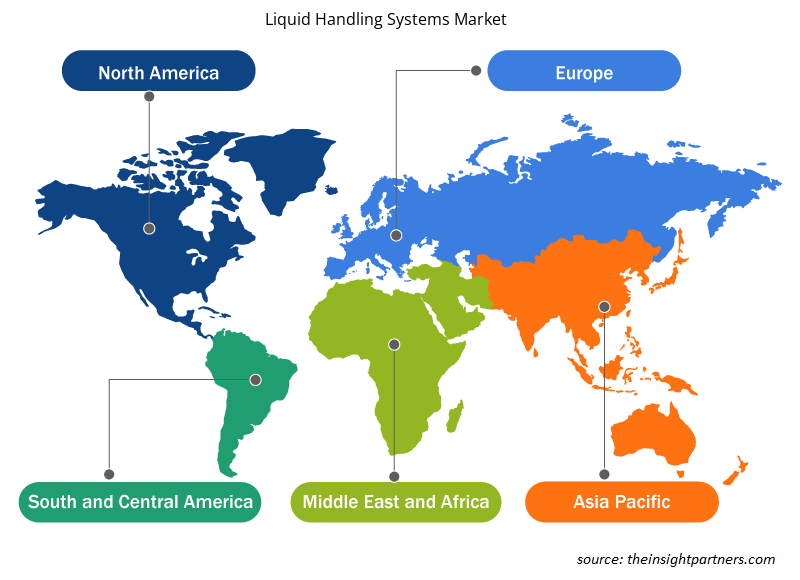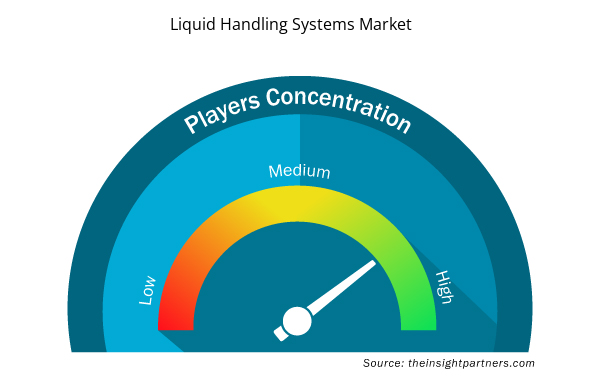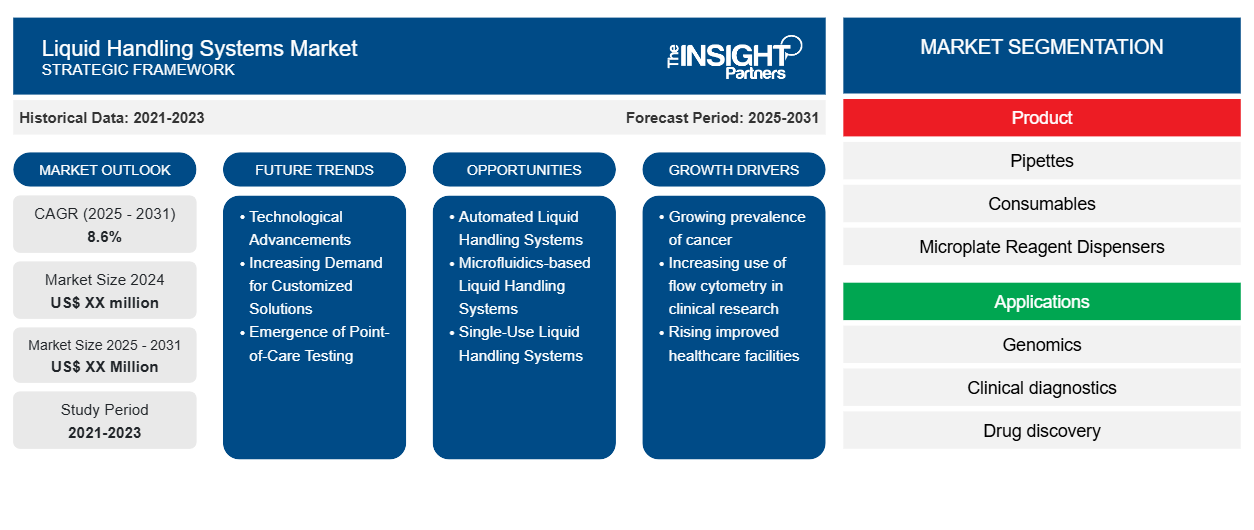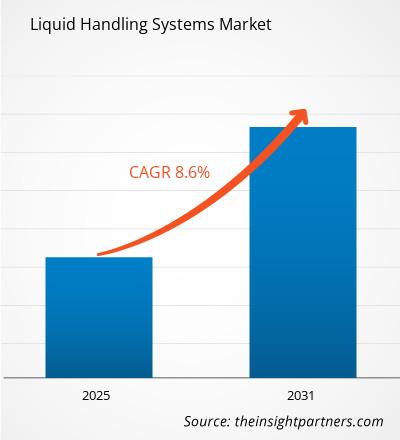液体処理システム市場は、2023年から2031年にかけて8.6%のCAGRで成長すると予想されており、市場規模は2023年のXX百万米ドルから2031年にはXX百万米ドルに拡大すると予想されています。
レポートは、製品(ピペット、消耗品、マイクロプレート試薬ディスペンサー、液体処理ワークステーション、ビュレット、マイクロプレートウォッシャー、ソフトウェア、およびその他の製品)、アプリケーション(ゲノミクス、臨床診断、創薬、プロテオミクス、その他)、およびエンドユーザー(学術および政府研究機関、バイオテクノロジーおよび製薬会社、病院および診断ラボ、その他)別にセグメント化されています。グローバル分析は、地域レベルと主要国でさらに細分化されています。レポートは、上記の分析とセグメントに対して米ドルでの価値を提供します。
報告書の目的
The Insight Partners のレポート「液体処理システム市場」は、現在の状況と将来の成長、主な推進要因、課題、機会を説明することを目的としています。これにより、次のようなさまざまなビジネス関係者に洞察が提供されます。
- テクノロジープロバイダー/メーカー: 進化する市場の動向を理解し、潜在的な成長機会を把握することで、情報に基づいた戦略的意思決定が可能になります。
- 投資家: 市場の成長率、市場の財務予測、バリュー チェーン全体に存在する機会に関する包括的な傾向分析を実施します。
- 規制機関: 市場の濫用を最小限に抑え、投資家の信用と信頼を維持し、市場の完全性と安定性を維持することを目的として、市場における政策と警察活動を規制します。
液体処理システム市場のセグメンテーション
製品
- ピペット
- 消耗品
- マイクロプレート試薬ディスペンサー
- 液体処理ワークステーション
- ビュレット
- マイクロプレートウォッシャー
- ソフトウェア
- その他の製品
アプリケーション
- ゲノミクス
- 臨床診断
- 創薬
- プロテオミクス
- その他
エンドユーザー
- 学術機関および政府研究機関
- バイオテクノロジーおよび製薬会社
- 病院および診断研究所
- その他
地理
- 北米
- ヨーロッパ
- アジア太平洋
- 南米と中央アメリカ
- 中東およびアフリカ
地理
- 北米
- ヨーロッパ
- アジア太平洋
- 南米と中央アメリカ
- 中東およびアフリカ
要件に合わせてレポートをカスタマイズする
このレポートの一部、国レベルの分析、Excelデータパックなど、あらゆるレポートを無料でカスタマイズできます。また、スタートアップや大学向けのお得なオファーや割引もご利用いただけます。
- このレポートの主要な市場動向を入手してください。この無料サンプルには、市場動向から見積もりや予測に至るまでのデータ分析が含まれます。
液体処理システム市場の成長要因
- がん罹患率の増加: がん患者数の増加は、正確かつ迅速な実験室検査と分析に対する大きな需要を生み出し、液体処理システム市場の成長に大きく貢献しています。液体処理システムは、臨床研究室、診断研究室、医薬品製造工場など、さまざまな目的で研究室で利用されており、液体状態の血液、組織、医薬品などの液体を管理および制御します。
- 臨床研究におけるフローサイトメトリーの使用増加: 臨床研究におけるフローサイトメトリーの採用増加も、液体処理システム市場の成長を後押ししています。フローサイトメトリーとは、サイズ、形状、表面マーカーなどの特定の細胞品質特性の判定に利用される技術を指します。この技術は、がん細胞の特性を理解し、新しいがん関連バイオマーカーを発見するために、がん研究で広く応用されています。
- 医療施設の改善の増加: より優れた医療施設の必要性は、液体処理システム市場の成長に影響を与える重要な要因となっています。これらの改善された医療施設のほとんどは現在、患者のケアを最優先に考慮しており、汚染や薬剤エラーの可能性を最小限に抑えるために、自動化された正確な液体処理システムを導入しています。オーダーメイドの治療や療法の需要が高まっているため、微小なサンプルサイズと複雑なプロトコルを管理できる高度な液体処理システムの使用が必要になります。
液体処理システム市場の将来動向
- 技術の進歩: 技術の進歩とは、新しい技術や技法の創出や改善による液体処理システムの継続的な近代化と強化を包含する傾向です。これらは、単純なピペッティングや投与、分配技法から、自動化、ロボット工学、さらには人工知能 (AI) がシステムに統合された複雑で自動化された液体処理システムまで多岐にわたります。
- カスタマイズされたソリューションに対する需要の増加: カスタマイズされたソリューションに対する需要の増加: この傾向は、特定の顧客のニーズを満たす液体処理システムの使用が増加していることを示しています。これは、特定の顧客向けに CNC 加工されたシステム、特注のソフトウェア、または特定の業界やクライアント向けに提供されるトレーニングの形をとる場合があります。
- ポイントオブケア検査の出現: POC 検査とは、遠隔地の実験施設ではなく、患者の近くで医療専門家が行う患者サンプルの検査と定義されます。その結果、POC 検査の急増により、診療所、病院、さらには患者の自宅でも適用できる、持ち運び可能で使いやすい液体処理システムの開発の必要性が高まっています。
液体処理システムの市場機会
- 自動液体処理システム : 自動液体処理システム: 実験室の作業における効率性と精度の向上に対するニーズが高まっているため、自動液体処理システムが採用されています。企業は、人手を必要とせずにさまざまな機能を一度に実行できる自動システムを開発して市場に投入し、それによって生産レベルを向上させることができます。
- マイクロ流体ベースの液体処理システム: 小型空間での液体処理の制御は、マイクロ流体技術によって変化しています。たとえば、企業はポイントオブケア診断や精密医療用のマイクロ流体ベースのシステムを考案できます。小型でコンパクトな液体処理システムやマイクロ液体処理システムの需要はますます高まっています。市場関係者は、多くの用途に適用できるポケットに優しい合理化されたシステムを設計することで、このトレンドを活用できます。
- 使い捨て液体処理システム: 汚染に対する懸念とコスト削減の必要性から、製薬業界では使い捨てシステムの需要が高まっています。組織は、汚染のリスクを最小限に抑えながら、使いやすくコスト効率の高い使い捨て液体処理システムを開発および製造できます。市場関係者は、使い捨て液体処理システムの進歩を通じて現在の傾向を活用できます。
液体処理システム市場の地域別分析
予測期間を通じて液体処理システム市場に影響を与える地域的な傾向と要因は、Insight Partners のアナリストによって徹底的に説明されています。このセクションでは、北米、ヨーロッパ、アジア太平洋、中東およびアフリカ、南米および中米にわたる液体処理システム市場のセグメントと地理についても説明します。

- 液体処理システム市場の地域別データを入手
液体処理システム市場レポートの範囲
| レポート属性 | 詳細 |
|---|---|
| 2023年の市場規模 | XX百万米ドル |
| 2031年までの市場規模 | XX百万米ドル |
| 世界のCAGR(2023年~2031年) | 8.6% |
| 履歴データ | 2021-2022 |
| 予測期間 | 2024-2031 |
| 対象セグメント | 製品別
|
| 対象地域と国 | 北米
|
| 市場リーダーと主要企業プロフィール |
|
液体処理システム市場のプレーヤー密度:ビジネスダイナミクスへの影響を理解する
液体処理システム市場は、消費者の嗜好の変化、技術の進歩、製品の利点に対する認識の高まりなどの要因により、エンドユーザーの需要が高まり、急速に成長しています。需要が高まるにつれて、企業は提供を拡大し、消費者のニーズを満たすために革新し、新たなトレンドを活用し、市場の成長をさらに促進しています。
市場プレーヤー密度とは、特定の市場または業界内で活動している企業または会社の分布を指します。これは、特定の市場スペースに、その市場規模または総市場価値に対してどれだけの競合相手 (市場プレーヤー) が存在するかを示します。
液体処理システム市場で事業を展開している主要企業は次のとおりです。
- ダナハーコーポレーション
- サーモフィッシャーサイエンティフィック株式会社
- エッペンドルフAG
- テカングループ株式会社
- ガードナーデンバーメディカル
免責事項:上記の企業は、特定の順序でランク付けされていません。

- 液体処理システム市場のトップキープレーヤーの概要を入手
主なセールスポイント
- 包括的なカバレッジ: レポートでは、液体処理システム市場の製品、サービス、タイプ、エンドユーザーの分析を包括的にカバーし、全体的な展望を提供します。
- 専門家による分析: レポートは、業界の専門家とアナリストの深い理解に基づいてまとめられています。
- 最新情報: このレポートは、最新の情報とデータの傾向を網羅しているため、ビジネスの関連性を保証します。
- カスタマイズ オプション: このレポートは、特定のクライアント要件に対応し、ビジネス戦略に適切に適合するようにカスタマイズできます。
したがって、液体処理システム市場に関する調査レポートは、業界のシナリオと成長の見通しを解読し理解する道の先導役となることができます。正当な懸念事項がいくつかあるかもしれませんが、このレポートの全体的な利点は欠点を上回る傾向があります。
- 過去2年間の分析、基準年、CAGRによる予測(7年間)
- PEST分析とSWOT分析
- 市場規模価値/数量 - 世界、地域、国
- 業界と競争環境
- Excel データセット



Report Coverage
Revenue forecast, Company Analysis, Industry landscape, Growth factors, and Trends

Segment Covered
This text is related
to segments covered.

Regional Scope
North America, Europe, Asia Pacific, Middle East & Africa, South & Central America

Country Scope
This text is related
to country scope.
よくある質問
The Liquid Handling Systems market is estimated to grow with a CAGR of 5.1% from 2023 to 2031.
Asia Pacific region is likely to witness fastest growth rate during the forecast period.
The market drivers include Growing prevalence of cancer and Increasing use of flow cytometry in clinical research are driving the Liquid Handling Systems market
The Liquid Handling Systems market majorly consists of the players such as Thermo Fisher Scientific Inc., Danaher Corporation, Eppendorf AG among others.
Technological Advancements are likely to remain the key trend during the forecast period
North America dominated the Liquid Handling Systems market in 2023
Trends and growth analysis reports related to Life Sciences : READ MORE..
1. Danaher Corporation
2. Thermo Fisher Scientific Inc.
3. Eppendorf AG
4. Tecan Group Ltd.
5. Gardner Denver Medical
6. Mettler-Toledo International Inc.
7. Hamilton Company
8. PerkinElmer, Inc.
9. Sartorius AG
10. Corning Incorporated
The Insight Partners performs research in 4 major stages: Data Collection & Secondary Research, Primary Research, Data Analysis and Data Triangulation & Final Review.
- Data Collection and Secondary Research:
As a market research and consulting firm operating from a decade, we have published and advised several client across the globe. First step for any study will start with an assessment of currently available data and insights from existing reports. Further, historical and current market information is collected from Investor Presentations, Annual Reports, SEC Filings, etc., and other information related to company’s performance and market positioning are gathered from Paid Databases (Factiva, Hoovers, and Reuters) and various other publications available in public domain.
Several associations trade associates, technical forums, institutes, societies and organization are accessed to gain technical as well as market related insights through their publications such as research papers, blogs and press releases related to the studies are referred to get cues about the market. Further, white papers, journals, magazines, and other news articles published in last 3 years are scrutinized and analyzed to understand the current market trends.
- Primary Research:
The primarily interview analysis comprise of data obtained from industry participants interview and answers to survey questions gathered by in-house primary team.
For primary research, interviews are conducted with industry experts/CEOs/Marketing Managers/VPs/Subject Matter Experts from both demand and supply side to get a 360-degree view of the market. The primary team conducts several interviews based on the complexity of the markets to understand the various market trends and dynamics which makes research more credible and precise.
A typical research interview fulfils the following functions:
- Provides first-hand information on the market size, market trends, growth trends, competitive landscape, and outlook
- Validates and strengthens in-house secondary research findings
- Develops the analysis team’s expertise and market understanding
Primary research involves email interactions and telephone interviews for each market, category, segment, and sub-segment across geographies. The participants who typically take part in such a process include, but are not limited to:
- Industry participants: VPs, business development managers, market intelligence managers and national sales managers
- Outside experts: Valuation experts, research analysts and key opinion leaders specializing in the electronics and semiconductor industry.
Below is the breakup of our primary respondents by company, designation, and region:

Once we receive the confirmation from primary research sources or primary respondents, we finalize the base year market estimation and forecast the data as per the macroeconomic and microeconomic factors assessed during data collection.
- Data Analysis:
Once data is validated through both secondary as well as primary respondents, we finalize the market estimations by hypothesis formulation and factor analysis at regional and country level.
- Macro-Economic Factor Analysis:
We analyse macroeconomic indicators such the gross domestic product (GDP), increase in the demand for goods and services across industries, technological advancement, regional economic growth, governmental policies, the influence of COVID-19, PEST analysis, and other aspects. This analysis aids in setting benchmarks for various nations/regions and approximating market splits. Additionally, the general trend of the aforementioned components aid in determining the market's development possibilities.
- Country Level Data:
Various factors that are especially aligned to the country are taken into account to determine the market size for a certain area and country, including the presence of vendors, such as headquarters and offices, the country's GDP, demand patterns, and industry growth. To comprehend the market dynamics for the nation, a number of growth variables, inhibitors, application areas, and current market trends are researched. The aforementioned elements aid in determining the country's overall market's growth potential.
- Company Profile:
The “Table of Contents” is formulated by listing and analyzing more than 25 - 30 companies operating in the market ecosystem across geographies. However, we profile only 10 companies as a standard practice in our syndicate reports. These 10 companies comprise leading, emerging, and regional players. Nonetheless, our analysis is not restricted to the 10 listed companies, we also analyze other companies present in the market to develop a holistic view and understand the prevailing trends. The “Company Profiles” section in the report covers key facts, business description, products & services, financial information, SWOT analysis, and key developments. The financial information presented is extracted from the annual reports and official documents of the publicly listed companies. Upon collecting the information for the sections of respective companies, we verify them via various primary sources and then compile the data in respective company profiles. The company level information helps us in deriving the base number as well as in forecasting the market size.
- Developing Base Number:
Aggregation of sales statistics (2020-2022) and macro-economic factor, and other secondary and primary research insights are utilized to arrive at base number and related market shares for 2022. The data gaps are identified in this step and relevant market data is analyzed, collected from paid primary interviews or databases. On finalizing the base year market size, forecasts are developed on the basis of macro-economic, industry and market growth factors and company level analysis.
- Data Triangulation and Final Review:
The market findings and base year market size calculations are validated from supply as well as demand side. Demand side validations are based on macro-economic factor analysis and benchmarks for respective regions and countries. In case of supply side validations, revenues of major companies are estimated (in case not available) based on industry benchmark, approximate number of employees, product portfolio, and primary interviews revenues are gathered. Further revenue from target product/service segment is assessed to avoid overshooting of market statistics. In case of heavy deviations between supply and demand side values, all thes steps are repeated to achieve synchronization.
We follow an iterative model, wherein we share our research findings with Subject Matter Experts (SME’s) and Key Opinion Leaders (KOLs) until consensus view of the market is not formulated – this model negates any drastic deviation in the opinions of experts. Only validated and universally acceptable research findings are quoted in our reports.
We have important check points that we use to validate our research findings – which we call – data triangulation, where we validate the information, we generate from secondary sources with primary interviews and then we re-validate with our internal data bases and Subject matter experts. This comprehensive model enables us to deliver high quality, reliable data in shortest possible time.


 このレポートの無料サンプルを入手する
このレポートの無料サンプルを入手する